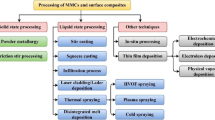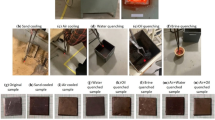Abstract
Magnetic abrasive machining is one of the advanced finishing processes that produce a high level of surface quality of any type. The productivity of the finishing process and the quality of the treated surfaces are determined by magnetic and abrasive properties of the working media. To synthesize effective magneto abrasive composites with the size range of 1–100 μm the intensive mechanical treatment of powdered mixtures of chemically inert (Fe:SiC, Fe:B4C and Fe:diamond) and exothermically reacting (Fe2O3:Fe:Me, Me = Al, Zr) systems in high-energy planetary ball mills is performed. It is shown that the formation of composites is the result of intensive processes of grinding and deformation (mechanical alloying) as well as of the mechanically intensified redox reactions (mechanochemical synthesis) leading to the formation of abrasive particles (MexOy) in iron matrix. X-ray diffraction, scanning electron microscopy, Mössbauer spectroscopy and investigations of mechanical properties accompanied by the measurements of the abrasive activity in the finishing process of the surface polishing are used for the characterization of the as-prepared composites. The main parameters and mechanisms of the formation of the optimal structure of composites are revealed. It is demonstrated that the smallest roughness of the machined surface (Ra ~ 1 nm) is achieved in the case of using the mechanically alloyed Fe/diamond composite and the mechanosynthesized Fe/ZrO2 composite.







Similar content being viewed by others
References
Khomich MS (2006) Magneto-abrasive treatment of products. Belarusian National Technical University, Minsk
Gillespie LK (2006) Mass finishing handbook. Magnetic-abrasive finishing, chapter 20. Industrial Press, New York, pp 371–401
Wang Yan, Dejin Hu (2005) Study on the inner surface finishing of tubing by magnetic abrasive finishing. Int J Machine Tools and Manufacture 45:43–49
Baron YM (1975) Tekhnologiya abrazivnoy obrabotki v magnitnom pole [technology of abrasive processing in magnetic field]. Mashinostroyeniye Publ, Leningrad, pp 43–46 (in Russian)
Singh L, Khangura SS, Mishra PS (2010) Performance of abrasives used in magnetically assisted finishing: a state of the art review. Int J Abras Technol 3(3):215–227
Feygin S, Kremen G, Igelstyn L (1998) Magnetic-abrasive powder and method of producing the same, US Patent 5846270
Lomovskiy S (ed) (2010) Mechanocomposites—precursors for materials with new properties. SB RAS, Novosibirsk
Suryanarayana C (2001) Mechanical alloying and milling. Prog Mater Sci 46:1–184
Takacs L (2002) Self-sustaining reactions induced by ball milling. Prog Mater Sci 47:355–414
Kiseleva TYu, Novakova AA, Grigoryeva TF et al (2008) Mechanosynthesis of corundum intermetallics composites. Perspektivnye materialy [Promising Materials] 6:11–20 (in Russian)
Kiseleva TYu, Novakova AA, Grigoryeva TF et al (2010) Mechanochemically induced formation of amorphous phase at oxide nanocomposite interfaces. J Phys: Conf Ser 217(1):012106. https://doi.org/10.1088/1742-6596/217/1/012106
Butyagin PY (1989) Active states in mechanochemical reactions. CRC Press, Boca Raton
Kiseleva TYu, Letsko AI, Talako TL, Kovaleva SA, Grigorieva TF, Novakova AA, Lyakhov NZ (2015) Mechanochemically synthesized powder precursors local structure influence on the microstructure of SHS Fe2O3/Fe/Zr/ZrO2 composites. Nanotechnol Russ 10(3–4):220–230
Rogachev AS, Moskovskikh DO, Nepapushev AA, Sviridova TA, Vadchenko SG, Rogachev SA, Mukasyan AS (2015) Experimental investigation of milling regimes in planetary ball mill and their influence on structure and reactivity of gasless powder exothermic mixtures. Powder Technol 274:44–52
Iasonna A, Magini M (1996) Power measurements during mechanical milling. An experimental way to investigate the energy transfer phenomena. Acta Mater 44(3):1109–1117
Borunova AB, Zhernovenkova YV, Streletskiy AN, Portnoy VK (1999) Determination of the energy intensity of mechanoactivators of various types. Obrabotka dispersnykh materialov i sred [Processing of Dispersed Materials and Media] 9:158–163 (in Russian)
Balzar D, Ledbetter H (1993) Voigt-function modeling in fourier analysis of size- and strain-broadened x-ray diffraction peaks. J Appl Crystallogr 26(1):97–103
Khomich MS (2015) Magnetic abrasive processing of surfaces of responsible products. Nauka i innovatsii [The Science and Innovations] 6:24–26 (in Russian)
Benjamin JS (1976) Mechanical alloying. Sci Am 234(5):40–48
Lovshenko FG, Lovshenko GF (2013) Kompozitsionnyye nanostrukturnyye mekhanicheski legirovannyye poroshki dlya gazotermicheskikh pokrytiy [Nanostructured mechanically alloyed composite powders for gas-thermal coatings]. Belorus-Rus Univ Publ, Mogilev
Polyakov AO, Kiseleva TYu, Novakova AA, Grigoryeva TF et al (2010) Step-by-step powder composite mechanosynthesis for functional nanoceramics. J Phys: Conf Ser 217(1):012081. https://doi.org/10.1088/1742-6596/217/1/012081
Grigoryeva TF, Barinova AP, Lyakhov NZ (2001) Mechanochemical synthesis of intermetallic compounds. Russ Chem Rev 70(1):45–63
Yen BK, Aizawa T, Kihara J (1996) Synthesis and formation mechanism of molybdenum silicides by mechanical alloying. Mater Sci Eng A220(1–2):8–14
Duraes L, Costa BFO, Santos R, Correia A, Campos J, Portugal A (2007) Fe2O3/aluminum thermite reaction intermediate and final products characterization. Mater Sci Eng A465:199–210
Acknowledgements
This work was carried out within the framework of the project BRFFR-RFFR supported by Belarusian Republican Foundation for Fundamental Research (BRFFR Grant No. T15CO-005) and Siberian Branch of Russian Academy of Science (Integration Program—No. 8).
Author information
Authors and Affiliations
Corresponding author
Ethics declarations
Conflict of interest
The authors declared that they have no conflict of interest.
Rights and permissions
About this article
Cite this article
Kovaliova, S., Šepelák, V., Grigoreva, T. et al. Mechanosynthesis of composites in chemically non-reacting and exothermically reacting systems for magnetic abrasive media. J Mater Sci 53, 13560–13572 (2018). https://doi.org/10.1007/s10853-018-2463-5
Received:
Accepted:
Published:
Issue Date:
DOI: https://doi.org/10.1007/s10853-018-2463-5




